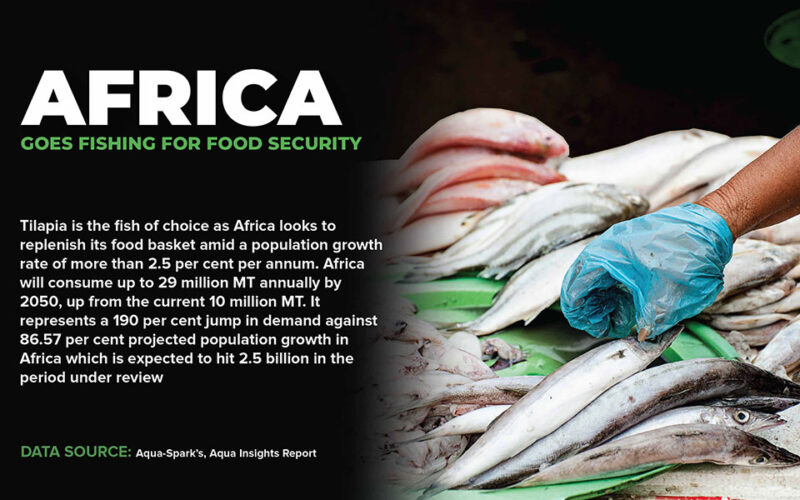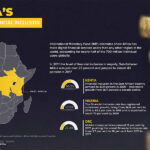SETH ONYANGO, BIRD
MORE tilapia are finding their way onto African plates – and palates – as rapid population growth in Africa fuels demand for locally-produced fish and opening up a multi-billion dollar market for ‘aquapreneurs.’
Aqua-Spark’s new Aqua Insights Report show the continent will consume up to 29 million MT annually by 2050, up from the current 10 million MT.
It represents a 190 per cent jump in demand against 86.57 per cent projected population growth in Africa which is expected to hit 2.5 billion in the period under review.
On the menu is farmed tilapia, a freshwater fish, which according to Aqua-Spark, “offers a scalable, sustainable and affordable means of feeding the region’s growing population.”
“While freshwater fish is entirely consumed within sub-Saharan Africa, a portion of marine fish production, around 1 million MT, is exported. Local production is complemented by 1-2 million MT of imported fish,” reads Aqua Insights in part.
“We don’t doubt that farmed tilapia production in sub-Saharan Africa will grow,” Willem van der Pijl of Aqua-Spark said.
“Demand for fish will far exceed the 10 million MT of today and by 2050 may reach between 16-29 million MT per year. Due to overexploitation, wild catch can’t be increased, and thus won’t be able to meet the additional demand. We believe that aquaculture production will have to accelerate and have identified tilapia to be the fish to do so: it’s scalable and it’s healthy, sustainable, and affordable.”
Aqua Insights shows tilapia is currently the second-most farmed fish in the world and the most farmed fish in Africa.
“Although many tilapia species are native to sub-Saharan Africa, the region’s farmed tilapia production is negligible compared to major producers such as Brazil, China, and Egypt (it is noteworthy that Egypt is in Africa – eds),” says the report.
China, which first introduced tilapia farming commercially in the 1980s, has seen production grow from almost nothing to 1.8 million tons in 2019. However, conditions for growing the fish in Africa – its native habitat – are optimal and there is huge potential to grow the sector. Egypt currently produces the most tilapia (scientific name Oreochromis niloticus, also known as Nile Tilapia or Oreochromis mossambicus, Mozambican Tilapia) by far in Africa and is the sixth-largest producer in the world, vaulting past Noway and Chile in overall fish farming production. The north African country has some 115,000 hectares of fish farms and produces over 1 million tons of tilapia per annum, according to thefishsite.com at an annual increase of some 8 percent over the past decade.
However, there is plenty of room for growth in other counties. A 2019 WorldFish study found that if the aquaculture sector in Africa continues on its current path, the per capita consumption of fish would gradually decline from 10 kg to 7.7 kg by 2050 because population growth would exceed food production and income levels.
“With fishermen reportedly being confronted with declining catches due to depleting wild stock, the production of wild-caught fisheries may flatten or even drop soon. Fishermen are therefore not in the position to meet the foreseen surge in demand,” Aqua Insights further says.
It is on that premise that investors are being urged to inject cash into aquaculture, with experts exuding confidence that the return on investment will be substantial.
Aquaculture presents an opportunity for increasing fish production in the face of growing demand for inland aquatic protein and limited scope for expanding wild fishery harvests.
Aqua Shark plans to launch a fund in the last quarter of the year dubbed “Aqua Shark Fund,” dedicated to aquaculture on the continent.
It will initially close at 50 million US dollars and will grow to 300 million US dollars over the next 6-8 years.
“This will kickstart the first phase of development: the most fundamental investments will be made to further develop the framework for the growth of sub-Saharan Africa’s aquaculture sector.
But Aqua-Spark notes that the challenge is that commercial tilapia producers in Africa are still struggling to compete with the cheaper Chinese small-sized tilapia.
“To expand their market reach, commercial producers could look down the chain in a bid to enter the space occupied by those providing the cheaper small-sized fish to the urban poorest,” it says in the Aqua Insight report.
“Or they could look up the chain and attempt to supply the more exclusive, large-sized fish to the wealthy few. But perhaps where commercial tilapia producers in sub-Saharan Africa really need to focus their attention is on the middle ground occupied by the urban middle class and compete with another protein entirely: chicken.”














